Understanding the Pull Broadcast Spreader


Intro
Using a pull broadcast spreader can truly transform how one approaches tasks in farming or horticulture. It’s not just another tool in the shed; it’s a game changer when it comes to distributing seeds, fertilizers, or any kind of granular material uniformly. Whether you're eyeing a freshly tilled garden plot or a sprawling field of crops, this kind of equipment ensures that every inch gets the care it needs without wasted efforts.
Key Insights
- Overview of the Topic
Pull broadcast spreaders come in various sizes and styles, catering to the diverse needs within agriculture and gardening. They work by utilizing a simple mechanism: attaching to a tractor, an ATV, or even a lawn mower, they allow users to disperse materials evenly across the surface. This efficiency is vital for promoting optimal growth and ensuring resources are used wisely. - Importance in Agriculture/Horticulture/Agronomy
In today’s increasingly demanding environment, where maximizing yield is paramount, the role of pull broadcast spreaders can't be overstated. Proper application of seeds and fertilizers can mean the difference between a bountiful harvest and a disappointing yield. Not only do these devices improve the speed and accuracy of distribution, but they also help in reducing labor costs and minimizing material waste, which often plagues manual spreading methods.
Moreover, as farmers and garden enthusiasts alike strive for better practices, using a pull broadcast spreader aligns well with sustainable farming techniques. When materials are applied accurately, less runoff occurs, which can protect local water sources from contamination and help maintain healthy ecosystems.
"A farmer should be able to feed their family and the world, without harming the land. The pull broadcast spreader plays a key part in this sustainability journey through efficient practices."
Ultimately, the pull broadcast spreader is more than just a tool; it represents an important step toward advancing agricultural techniques and employing best practices that can lead to enhanced productivity and sustainability in our industry.
Prolusion to Pull Broadcast Spreaders
In the realm of agriculture and gardening, the tools we use can greatly influence the outcome of our labor. One such indispensable tool is the pull broadcast spreader. Designed explicitly for the efficient and uniform distribution of granular materials, such as seeds and fertilizers, this device can transform your planting experience into one that is both effective and enjoyable. Understanding the intricacies of pull broadcast spreaders not only enhances operational efficiency but also boosts the overall health of the crops you nurture.
Definition and Purpose
A pull broadcast spreader functions by accurately dispersing seeds, fertilizers, and other granular substances over a specified area. Unlike hand-held options, which often lead to inconsistencies and uneven patches, these spreaders attach to various types of vehicles, such as tractors or lawn mowers. As the machine moves, it accurately distributes product in a wide swath, ensuring that the material reaches every corner of your field or garden.
The purpose of using a pull broadcast spreader is multi-faceted:
- Efficiency: Covers large areas far quicker than manual methods, saving time and labor.
- Uniformity: Provides a consistent application, crucial for the healthy growth of plants.
- Reduced Waste: Minimizes excess material, resulting in better resource management.
By integrating these spreaders into your agricultural practices, the potential for improved crop yield and quality increases significantly.
Historical Context
The evolution of the pull broadcast spreader is intertwined with the advancements in agricultural practices. The need for more efficient land management techniques arose with the growth of agriculture as a profession. Early methods of sowing seeds relied heavily on manual labor and rudimentary tools. For instance, a simple seed drill designed in the early 18th century allowed for better seed placement, but it wasn't until the late 19th century that the modern pull broadcast spreader began to emerge.
Initially crafted from wood and later incorporating metal, these machines saw numerous design improvements over the decades. The advent of mechanical innovations in the 20th century led to the creation of automated models, enhancing ease of use. Today, pull broadcast spreaders come in various forms, allowing farmers and gardening enthusiasts to select models based on their specific needs. The transition from manual seeding to efficient spreading machines reflects the ongoing journey in agricultural technology, aligning with the ever-increasing demand for higher productivity and sustainability.
Understanding where this tool came from can help enthusiasts appreciate its value in contemporary agriculture, making it clear that utilizing a pull broadcast spreader is not merely a trend but a vital practice borne from years of refinement and evolution.
Types of Pull Broadcast Spreaders
When it comes to gardening and agriculture, selecting the right pull broadcast spreader can make a world of difference. Understanding the different types available not only helps in optimizing your efforts but also ensures that your materials are spread evenly over your desired area. In this section, we will delve into the primary types of pull broadcast spreaders, highlighting specific characteristics and benefits that will be instrumental for any farmer or gardening enthusiast.
Tow-Behind Models
Tow-behind models are designed for those who have access to a vehicle or garden tractor capable of towing. These spreaders typically offer a bigger hopper capacity, which means less refilling during operation—a welcome feature for large fields or extensive vegetable gardens. Generally, they attach easily to the back of a riding mower or ATV, giving users the flexibility to cover a larger area much faster.
One notable advantage of these models is their adjustable spread width. Most tow-behind models allow operators to control how far the materials are spread, making it easier to apply different types of fertilizers or seeds according to particular needs. Moreover, they often feature durable construction designed to handle rough terrain, providing longevity against wear and tear.
Here's why tow-behind models may be the right choice:
- Increased Capacity: Less frequent refills.
- Varied Spread Width: Adjust grain application as necessary.
- Durability: Built to withstand outdoor conditions.
"A larger spreader means less time spent refilling, and more time cultivating your crops."
Pull-Behind Versus Handheld Options
When weighing the options between pull-behind and handheld spreaders, it’s essential to consider the scale of your gardening or farming. Handheld models, while compact and easy to store, are better suited for smaller gardens or specific tasks where fine precision is needed. They offer the advantage of portability, allowing the user to maneuver easily through tight spots that larger models can’t touch.
On the other hand, pull-behind spreaders shine in larger applications and are generally more efficient for bigger areas. They do require some investment into a towing vehicle, but for many, this is quickly justified through time and effort saved.
Comparing the two types helps clarify their respective strengths:
- Pull-Behind: Efficient for larger applications, higher capacity.
- Handheld: Ideal for intricate work in smaller spaces, easy handling.
Electric and Manual Variants
The choice between electric and manual pull broadcast spreaders introduces another crucial layer of decision-making. Electric models typically rely on battery power and are often equipped with features that allow greater control over material flow. For example, some electric variants come with settings that can adjust the speed of dissemination, which might be particularly useful for delicate products or variable materials.
In contrast, manual spreaders are traditionally more affordable and don't deal with battery life or malfunctioning electronics. They require more physical effort but can be simpler to maintain and operate for those who prefer a no-frills approach. Manual spreaders can also offer a sense of connection to the task at hand, allowing users to appreciate the physical aspect of their work.
Here’s a look at the pros of each:
- Electric Variants: Precision control, reduced physical effort.
- Manual Options: Cost-effective, straightforward operation, minimal maintenance.
In summary, the type of pull broadcast spreader chosen can significantly influence efficiency and effectiveness in both garden and agricultural settings. Understanding the features and benefits of each type ensures that users can tailor their choice to meet the specific demands of their projects.
Mechanics of a Pull Broadcast Spreader
Understanding the mechanics of a pull broadcast spreader is crucial for unlocking its full potential. This section examines the inner workings of these tools, emphasizing how various components contribute to their overall effectiveness. When you embrace these mechanics, you pave the way for a more successful application of seeds, fertilizers, and other materials.
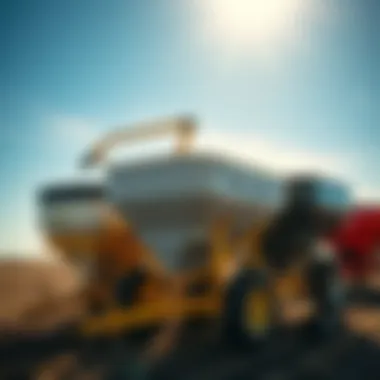
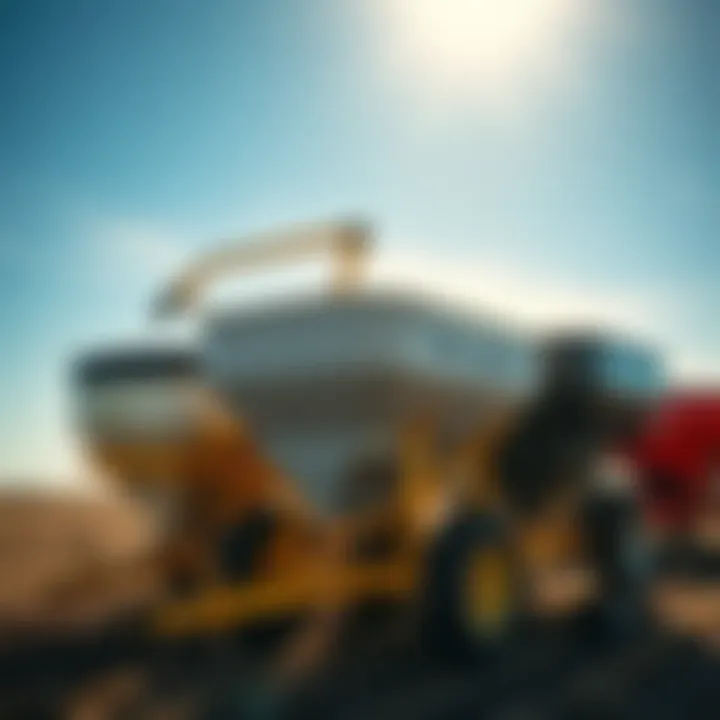
Dispersion Mechanism
The dispersion mechanism is the heart of a pull broadcast spreader. It’s the system designed to evenly distribute materials across the ground. Most commonly, the spreader utilizes a rotating tray or disc, which throws the material outward as it spins.
"A well-functioning dispersion mechanism can make all the difference between a lush garden and a dry patch of earth."
What makes this mechanism such an asset is its ability to cover a larger area quickly. As the spreader is pulled, the disc spins at a designated speed determined by the operator. This speed impacts how far the material travels from the spreader, leading to a balanced coverage of the intended area.
The versatility in this design means you can use various materials, whether it's granular fertilizers, seeds, or ice melt. The ability to select materials adds to the tool’s charm, allowing users to adapt to different applications, fostering that sense of backyard pride.
Adjustment Factors
Adjustment factors play a substantial role in achieving optimal performance with a pull broadcast spreader. Three primary factors come into play: rate of flow, swath width, and terrain considerations. Understanding these elements enables users to apply the correct amount of materials effectively and efficiently.
Rate of Flow
The rate of flow refers to how much material is dispensed per unit area. Setting the correct rate ensures that you neither underfeed nor overfeed your soil. A common rule of thumb is to follow the directions on your material’s package. Yet, adjusting this rate can have profound impacts on your outcomes.
One key characteristic of flow rate is its ability to be fine-tuned based on what you're spreading. For example, if you're dispersing fertilizer, you might want a higher flow rate to ensure sufficient nutrition.
- Benefits:
- Disadvantages:
- Optimize growth potential
- Reduce wastage of materials
- Over-application can lead to nutrient runoff, harming the environment.
This adaptability helps reinforce the importance of knowing your materials before setting off on your spreading journey.
Swath Width
Swath width is the distance the spreader covers in a single pass. Broad swath widths are advantageous for large areas, reducing the number of passes needed to achieve complete coverage. Conversely, narrower swath widths offer precision for delicate applications, like landscaping around existing plants.
- Key Characteristic:
- Advantages:
- Disadvantages:
- Allows for customization based on the project's demands.
- Increased efficiency in large-scale applications.
- Narrow swath widths may require more time and effort for extensive areas, making it less efficient in such contexts.
Knowing how to manipulate the swath width effectively lets users pull off an impressive display of greenery or blooming flowers.
Terrain Considerations
Terrain considerations can’t be ignored. The nature of the ground where you're spreading can significantly impact how well the materials are distributed. Factors like slope, type of soil, and existing vegetation influence not only the spreading technique but also the overall effectiveness of the application.
- Characteristic:
- Advantages:
- Disadvantages:
- Adapting to slopes or uneven ground ensures success.
- Tailoring techniques leads to improved results on diverse landscapes.
- Difficult terrain might require alternative techniques or tools, leading to a potential increase in costs.
Understanding these terrain factors allows users to sidestep common pitfalls and maximize the tools' efficiency in various landscapes.
Benefits of Using a Pull Broadcast Spreader
When it comes to ensuring effective distribution of seeds, fertilizers, or any granular material in your gardens or fields, using a pull broadcast spreader comes with a slew of advantages. This tool isn't just a passing trend; rather, it is a staple in the toolkit of many agricultural professionals. Here, we will break down the benefits this implement brings to the table, emphasizing its relevance in farming and gardening practices.
Efficiency in Coverage
One of the standout features of pull broadcast spreaders is their ability to cover large areas uniformly. Unlike hand broadcasting, which can leave patchy spots where material is over-applied or under-applied, these spreaders ensure an even distribution.
- Wide Swath: Most pull broadcast spreaders can be adjusted to cover a broader swath, allowing you to tackle larger plots in a fraction of the time.
- Precision: They provide consistency, delivering the right amount of products where they are needed most. This can be crucial in maintaining healthy plant growth.
- Less Physical Strain: Pulling a spreader behind a tractor or garden vehicle means less physical labor compared to tossing seed or fertilizer by hand. This can be especially beneficial for those managing bigger fields.
By maximizing coverage and minimizing labor, these spreaders stand as indispensable tools for effective gardening and farming practices.
Time-Saving Attributes
Time is often more valuable than gold in agriculture, and pull broadcast spreaders deliver on this front. With various models catering to different needs, utilizing a pull broadcast spreader can trim down the hours spent on manual work.
- Rapid Deployment: You can quickly load your spreader and start the job. There's no need to fill it multiple times or waste minutes making sure everything is evenly distributed by hand.
- Automated Efficiency: Many modern spreaders even come with features like variable rate control, allowing users to set specifics tailored to their land's requirements.
- Reduced Work Hours: Less time spent dispersing means more time for other critical tasks within farming or gardening, which is vital for maximizing productivity.
With pull broadcast spreaders, the often notorious task of distribution becomes much simpler and quicker, allowing for better time management overall.
Reduction of Waste
When it comes to handling seeds or fertilizers, maximizing product utilization is paramount. Pull broadcast spreaders significantly decrease waste, which, in turn, can have positive economic implications.

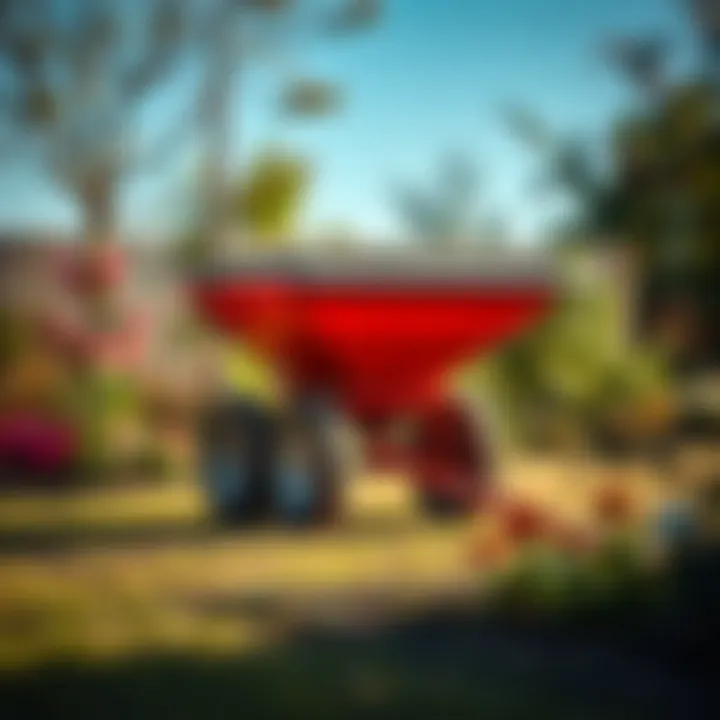
- Targeted Application: These tools help to ensure that the materials are spread evenly, reducing the chances of runoff or piles forming in an undesired manner. This means you're not paying for, and then losing, what you throw away unknowingly.
- Economic Efficiency: It is not just about the immediate application; proper use of a pull broadcast spreader can lead to long-term savings as less material goes to waste. Over time, these savings can accumulate, impacting your overall budget positively.
- Environmental Benefits: By reducing excess runoff into surrounding environments, these spreaders also support environmentally responsible farming practices.
In summary, choosing to utilize a pull broadcast spreader leads to substantial operational benefits in efficiency, time management, and resource conservation. These advantages make for an easy argument in favor of investing in this essential tool for both hobbyists and seasoned farmers alike.
Selecting the Right Pull Broadcast Spreader
Choosing the right pull broadcast spreader might seem like a no-brainer, but, as many seasoned users will tell you, it’s a decision that can make or break your gardening or farming experience. Just as a bad tool can lead to uneven seed distribution, the right one can save you time and money while boosting your crop yield. Let’s break down what needs to be considered here.
Factors to Consider
Field Size and Type
When it comes to field size and type, understanding the dimensions and characteristics of your land is crucial. If you have a sprawling expanse of crops, a larger tow-behind model will be your best buddy. They not only cope with bigger spaces, but they also allow for efficient spreading, cutting down on the number of passes you need to make.
For instance, if your field is irregularly shaped or has multiple obstacles, a more maneuverable pull-behind spreader might just fit the bill. Think about it this way: having the right size for your task can streamline your work significantly.
Advantages of choosing the right field size and type:
- Time efficiency: Your efforts are maximized.
- Even distribution: Proper sizing means you won’t miss spots or overlap too much, saving materials.
Material Compatibility
The materials you plan to distribute greatly influence your choice of spreader. A spreader that excels with fertilizer might not cut it for seeds or ice melt. For example, if you’re tossing down granular fertilizer, a spreader with a larger hopper can allow for bigger loads, meaning fewer trips back to refill.
Conversely, finer materials like grass seed may require a spreader aerated sufficiently to avoid clogs. The unique feature of material compatibility ensures you’re equipped for the job at hand.
Key insights regarding material compatibility:
- Right tool for right job: Avoid mishaps that can lead to waste or damage.
- Better results: Correct compatibility aids in achieving optimal growth and coverage.
Budget and Investment
Budget considerations can often feel like a noose around one’s neck but understanding your potential options is critical. You don’t want to skimp too much on a device that won’t hold up over time, nor do you want to lavish your money on a model with features you won't utilize. A middle-tier spreader might balance the wallet while still providing adequate performance, especially for home gardeners or less demanding agricultural practices.
Evaluating product longevity will impact your budget in the long run; a well-maintained model can last years, providing ample value for the dollar spent.
Considerations when evaluating budget:
- Longevity vs. expense: Weigh upfront costs with expected lifespan.
- Features vs. needs: Assess if all the bells and whistles are essential for your operations.
Brand and Model Recommendations
When it comes to brand and model recommendations, seeking feedback and reviews is a wise approach. Popular brands offer reliability like EarthWay and Agri-Fab, known for catering to both home gardeners and professionals. Dive into reviews on sites such as reddit.com or even in specialized forums; they can serve as valuable resources in gauging real user experience.
Operating a Pull Broadcast Spreader
Operating a pull broadcast spreader is key to ensuring that your efforts in horticulture or agriculture yield the fruits—literally—that you desire. Whether you are scattering seeds or distributing fertilizers, understanding how to properly operate this tool is paramount. This section aims to enhance your grasp of such equipment, outlining the significance of pre-usage checks and providing best practices for optimal results.
Pre-Operational Checks
Before you hit the ground running, it’s essential to perform a set of checks that can prevent mishaps down the line. Think of it as a pre-flight checklist for a pilot. The last thing you want is a faulty spreader causing you a headache mid-operation.
Key Checks to Conduct:
- Inspect the Equipment: Look for any wear and tear, especially on moving parts. Cracks in the spreader frame could lead to malfunction. If it looks battered, it might be time to consider a repair or replacement.
- Calibration: Ensuring the spreader is calibrated to dispense the correct amount of material can save you both money and resources. Follow the manufacturer’s instructions for calibration settings. This step matters because over-applying can lead to wastage and under-applying can result in ineffective treatment.
- Wheel and Tire Condition: Inflate tires adequately and check for any issues that could affect mobility. A smooth ride helps maintain consistent distribution.
- Safety Features: Confirm that all safety mechanisms are functional to avoid accidents during use. Nothing beats peace of mind when you’re out in the field.
Best Practices for Use
Once you’ve ensured everything is shipshape, the next step is to employ techniques that will maximize your efficiency and the quality of your work.
Optimal Conditions for Application
It’s not just about how you use the spreader, but also when you do it. Timing can be everything, especially when dealing with environmental conditions.
- Ideal Weather: A calm day helps prevent drift, allowing even distribution without half the material getting blown away. Windy conditions can ruin your attempt to cover a specific area.
- Soil Condition: The ground should be neither too wet nor too dry. Soil that’s too soggy can lead to poor seed embedding, while dry soil may not allow for proper penetration of fertilizers.
Given these points, it becomes evident that applying materials during suitable conditions is among the best choices an operator can make.
Technique for Even Distribution
Even distribution hinges on the technique applied while using the pull broadcast spreader. The goal here is to cover every inch evenly, without leaving patches that could affect your overall results.
- Walking Speed: Maintaining a steady walking speed is crucial. If you race through it, you'll end up with clumps or gaps. A slow, steady speed ensures an even release of material.
- Overlap Passes: Make overlapping passes in your fields to ensure no spots get missed. This practice can safeguard your hard work and lead to optimal growth in your crops.
With such techniques in your toolkit, you're not just using a tool; you’re mastering the art of effective distribution.
Always remember that the spreader's performance is directly linked to how well you operate it. A sound understanding coupled with execution will lead to flourishing gardens and bountiful crops.
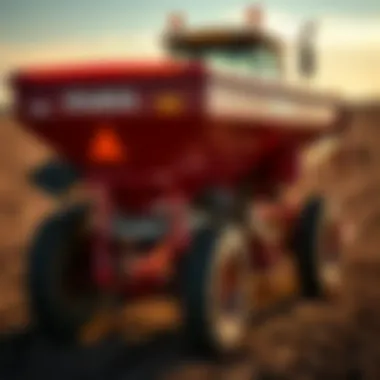
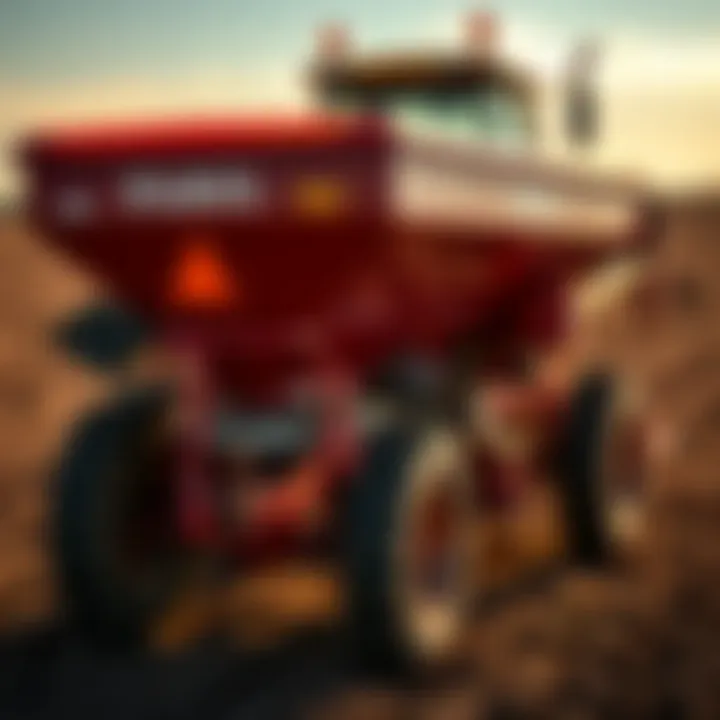
Maintenance and Care
Maintaining a pull broadcast spreader is not just an afterthought; it’s essential for ensuring the tool performs reliably over its lifespan. Proper maintenance and care can increase the efficiency of operations while minimizing costly repairs. A well-kept spreader also guarantees a wider and more consistent distribution of the materials you are using, be it seeds, fertilizers, or ice melt. It goes a long way in preserving the investment you made in purchasing this equipment while providing peace of mind in knowing it will work when you need it most.
Routine Maintenance Tasks
Regular maintenance tasks are a part of the ownership of any mechanical equipment, including pull broadcast spreaders. Below are some key tasks that should be on the checklist:
- Cleaning: After each use, it’s vital to clean the spreader thoroughly. Debris left behind can corrode components and lead to jamming. A gentle rinse with water and a soft cloth can do wonders.
- Inspecting Components: Every month, or before heavy usage seasons, check for any signs of wear on parts like the hopper, wheels, and axles. Looking for rust or cracks can save you from surprise breakdowns later.
- Lubrication: Apply lubricant to moving parts such as the axle or spreader’s mechanisms. This action helps reduce friction and prolongs the lifespan of these components.
- Tightening Bolts and Screws: Shaking and vibrations during use can loosen parts, leading to inefficient operation. A quick inspection can help spot loose screws that need tightening.
- Calibrating Settings: If your spreader offers adjustment settings for flow rate or swath width, check and recalibrate them regularly to ensure accurate application rates.
Storage Recommendations
Proper storage of a pull broadcast spreader is as significant as regular maintenance. Store your equipment in a clean, dry area to prevent rust and other forms of damage. Consider the following recommendations:
- Indoor Storage: Whenever possible, keep the spreader indoors. A garage or shed can prevent exposure to rain or snow, which would accelerate wear.
- Covering the Spreader: If indoor storage isn't feasible, consider using a tarp or protective cover to shield it from environmental elements.
- Placement: Avoid placing heavy objects on top of the spreader to prevent warping or other physical damage.
- Seasonal Checks: Before each planting or treating season, take the time to inspect and prepare your spreader. Ensure that it is functioning properly after a period of inactivity.
Proper maintenance and care not only extend the life of your pull broadcast spreader but also guarantee your investment continues delivering excellent performance when you need it.
Considering all these aspects of maintenance and care ensures that your pull broadcast spreader will serve you well through many seasons of agricultural duty, be it in your backyard garden or on a vast agricultural field. By investing time in these tasks, you'll save both time and money in the long run, enabling effectively managed operations.
Safety Considerations
Ensuring safety while operating a pull broadcast spreader is crucial for both the user and the surrounding environment. This is not just about personal protection; it also pertains to the effective and responsible use of machinery in agricultural settings. Overlooking safety precautions can lead to mishaps that may derail productive efforts, waste resources, and more importantly, cause injuries. Therefore, understanding the need for proper safety measures and adhering to them fosters a more secure working environment while enhancing the efficacy of the tasks undertaken.
Personal Protective Equipment
When working with a pull broadcast spreader, the appropriate personal protective equipment (PPE) cannot be overstated. Equiping yourself properly sets the stage for a safe application process. Here’s a checklist of essential gear:
- Safety Goggles: These protect your eyes from dust and debris that may be kicked up during operation. The last thing you want when applying fertilizers or seeds is for a stray particle to get in your eye.
- Gloves: Using gloves ensures your skin doesn’t come into direct contact with chemicals, which can sometimes be hazardous. Whether handling fertilizers or other granular materials, your hands deserve protection.
- Dust Mask: If you’re in an area where fine particles may be released into the air, a dust mask can help prevent inhalation of harmful substances.
- Sturdy Footwear: Heavy-duty, steel-toe boots provide protection from foot injuries, especially if the spreader or large bags of material are inadvertently dropped.
In addition to these items, wearing long pants and long sleeves can shield your body from incidental contact with harmful materials, as well as from sun exposure during long hours outdoors.
Operational Safety Guidelines
Using a pull broadcast spreader effectively involves following guidelines that reduce risks associated with its operation:
- Read the Manual: Familiarize yourself with the manufacturer’s instructions before hitting the field. Knowing how the specific model functions will aid in responding to any operational questions.
- Inspect the Equipment: Always conduct a pre-operational check. Look for wear and tear on parts, such as the spreader’s wheels and the distribution mechanism. Ensuring it’s in good working order minimizes the chance of accidents.
- Maintain Control of the Equipment: It’s essential to maintain a firm grip and control over the spreader, preventing it from tipping or getting away from you, especially on slopes.
- Watch Your Surroundings: Always be aware of your immediate environment. Keep bystanders and pets at a safe distance while operating the spreader to prevent any unexpected accidents.
- Avoid Operating on Slippery or Uneven Terrain: This can lead to loss of control over the spreader. Opt for stable and dry landscape to ensure safe operation.
- Safe Loading and Unloading: When filling the spreader, do it slowly, and avoid overloading. Not only does overloading increase the risk of mechanical failure, but it also makes the unit harder to control.
"A little caution goes a long way in preventing serious accidents."
In summary, personal protective equipment and operational safety guidelines play pivotal roles in the effective use of pull broadcast spreaders. The integration of these safety measures will not only safeguard the user but also enhance productivity while ensuring that the job at hand is completed efficiently. For more information on safety practices and PPE recommendations, websites like OSHA and CDC provide detailed resources to aid in ensuring a safer workspace.
Common Issues and Solutions
Common challenges tend to arise when operating pull broadcast spreaders. Understanding these issues can save time, money, and frustration. By troubleshooting effectively, both hobbyists and seasoned farmers can optimize the performance of their equipment. Here's a closer look at what might go wrong and how to address these hiccups.
Frequent Mechanical Problems
Mechanical issues can plague any equipment, and pull broadcast spreaders are no exception. Recognizing these issues early can prevent larger failures down the road. Here are a few frequent mechanical problems:
- Clogged Dispensing Mechanism: It’s not uncommon for granular materials to jam in the spreader's mechanism. This can lead to uneven distribution or complete stoppage. Clearing the area and ensuring the materials used are compatibility can alleviate this.
- Worn-Out Agitators: Agitators play a crucial role in helping to keep the material flowing evenly. If they become worn or damaged, it can lead to issues like uneven spreading. Regularly inspecting and replacing these components as needed is wise.
- Wheel and Axle Issues: If the wheels are not smoothly rotating, or if there’s play in the axle, this could hinder the spreader's operation. Lubricating moving parts and checking for any significant wear can help maintain functionality.
"Regular maintenance and prompt repairs can keep spreaders working efficiently, extending their lifespan and improving your output."
Addressing these mechanical issues promptly ensures your spreader remains effective for its intended purpose.
User Errors
User errors are a common pitfall when utilizing any piece of equipment. With pull broadcast spreaders, mistakes in operation can result in less-than-desirable outcomes. Here are some common user errors:
- Incorrect Settings: Many spreaders come with adjustable settings for fl ow rate and spread width. Not aligning these settings with the type of material or the field’s requirements can lead to uneven application. Always consult the user manual for the intended settings for specific tasks.
- Improper Loading Techniques: Loading material unevenly can throw off the balance of the spreader, leading to inconsistent distribution. It’s important to ensure that the material is loaded according to the manufacturer’s guidelines.
- Inattention to Terrain Conditions: Factors like slope and moisture can affect the spreader's performance. If operators do not adjust their technique accordingly, they may end up either over- or under-applying materials.
When using a pull broadcast spreader, take the time to familiarize yourself with the equipment and its limitations. By addressing both mechanical problems and common user errors, operators can ensure a smoother, more effective application process.
For more guidance on maintenance and troubleshooting, consider visiting resources such as Wikipedia for basic definitions and types, or check discussion groups on Reddit to see what common issues others are encountering.
Closure
The conclusion serves as the glue that binds together the various facets of the pull broadcast spreader. It allows the reader to reflect on the multitude of insights gathered throughout the article, reinforcing the notion that understanding this tool is pivotal for both agricultural professionals and gardening enthusiasts alike. By summarizing key elements, such as the different types of spreaders, their mechanics, and maintenance practices, this section drives home the importance of informed decision-making when it comes to selecting and operating a pull broadcast spreader.
One major benefit highlighted in this discussion is the efficiency that comes with using a well-chosen spreader. Efficient coverage can dramatically alter a farming operation, leading to increased productivity and potential cost savings. In an industry where every penny counts, the visibility of the benefits an appropriate spreader can provide is not something to overlook. This isn’t just about improving a workflow; it can mean the difference between a flourishing crop and a mediocre yield.
Moreover, considerations around safety and routine maintenance underscore the necessity of ongoing care for these tools. It’s crucial to recognize that a pull broadcast spreader is not merely a piece of equipment; it’s an investment. Proper understanding of its components, the common pitfalls during operation, and how to troubleshoot makes it a reliable ally in ensuring the tasks get done right the first time.
Finally, this conclusion captures the central message of the article: knowledge is power. Empowering oneself with thorough understanding and best practices is what can elevate average agricultural practices into something extraordinary. As farmers and hobbyists glean insights from this comprehensive guide, they not only sharpen their skills but also contribute to sustainable practices that impact the broader agricultural landscape.
"Knowledge is not power; it is only potential power. It becomes power only when, and if, it is organized into definite plans of action and directed to a definite end."
Final Thoughts on Pull Broadcast Spreaders
Pull broadcast spreaders have become integral to efficient agricultural and gardening practices. They are not just tools; they are gateways to enhancing productivity, ensuring even distribution, and minimizing waste of seeds and fertilizers. As we’ve explored, their mechanics, usage, and maintenance form the baseline understanding required for effective application.
When it comes time to transition from traditional methods to utilizing these devices, the learning curve might seem steep, but the rewards are often worth the time invested. Armed with the right knowledge, users will find themselves well-equipped to make choices that foster not only their success but also the health of the land they manage and care for. Each garden or farm plot stands to benefit from the carefully considered application of materials, leading to improved yields over time.
In closing, whether you are operating a sprawling farm or a small vegetable patch, embrace the role of technology in agriculture. Invest the time in understanding your pull broadcast spreader, and let it guide your path to agricultural excellence.







